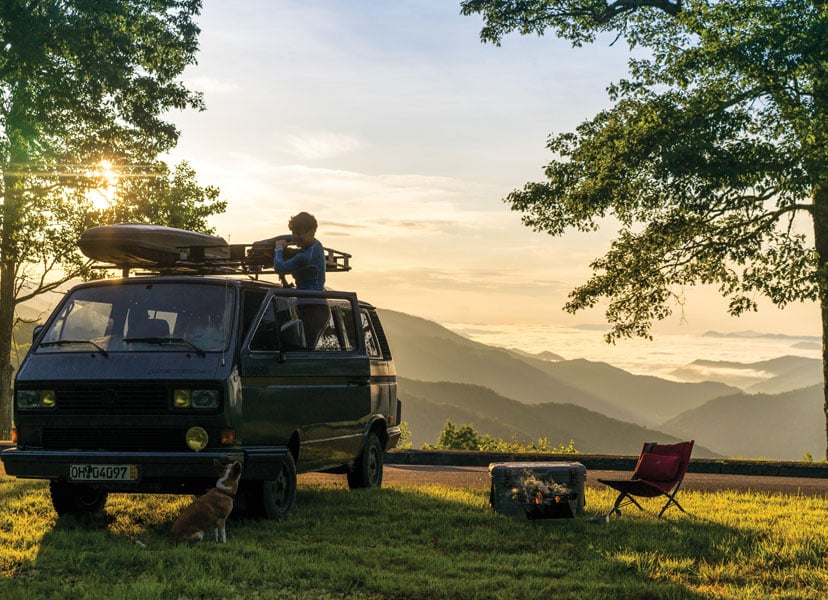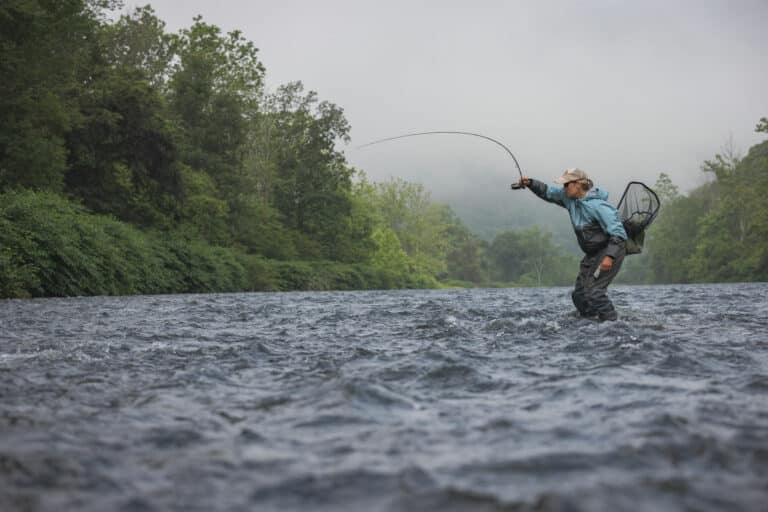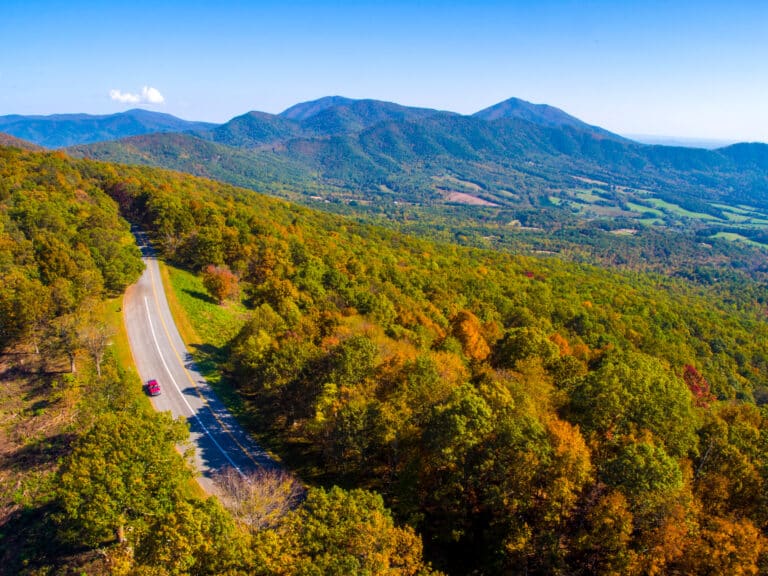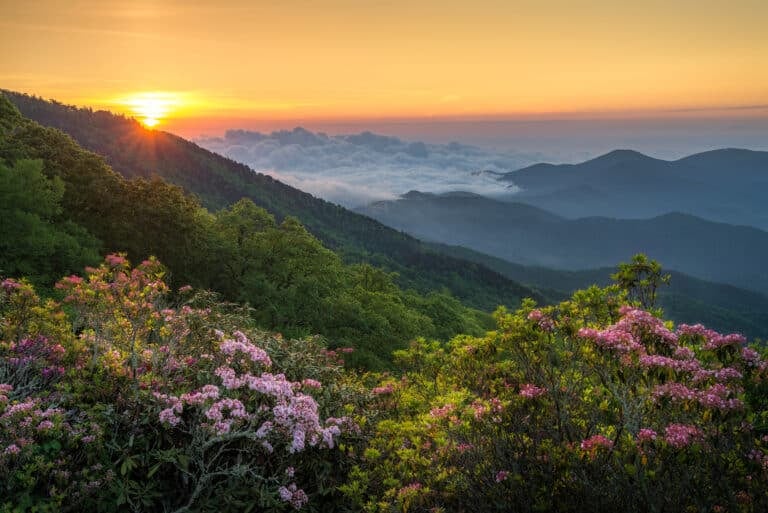Road trips aren’t just for families anymore. The following roadlifers are artists, athletes, and master tinkerers. Some are on the road full-time, others only seasonally. Their adventuremobiles come in all shapes and sizes, from DIY build-outs-on-a-budget to top-of-the-line off-roading rigs. Check out their roadlife journeys and tips for some summer road trip inspiration.
The Airstream
Andy + Jess Wickstrom
@eggtravels
For the better part of a decade, life for the Wickstroms was good. Having relocated to Chicago in 2003, the couple worked hard to acquire decent paying jobs, buy a condo, make friends. Their creative careers, by all appearances, were thriving. Jess organized art exhibitions and managed the gallery store at the Lillstreet Art Center, while Andy blossomed alongside a growing coffee company, Intelligentsia, to become its lead designer and multimedia content curator.
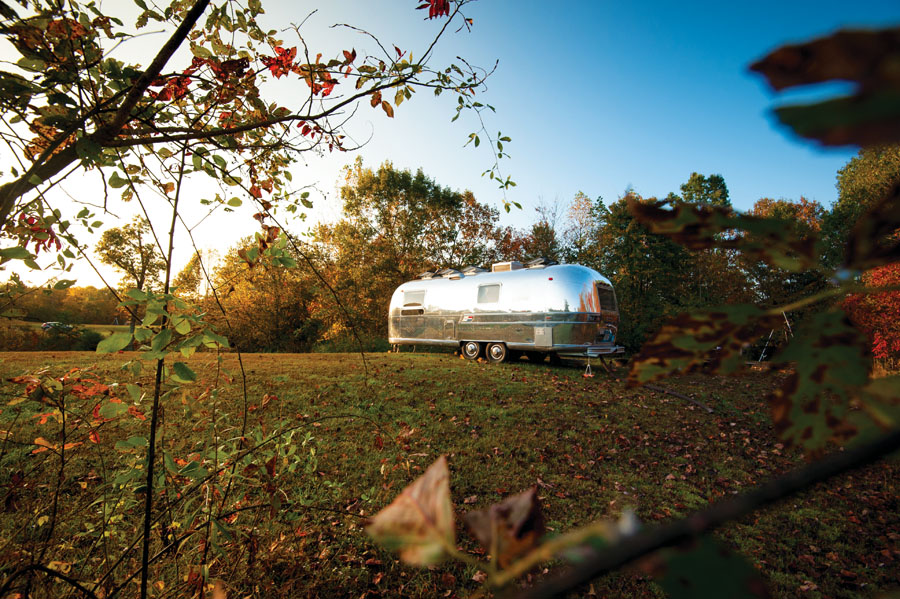
But all of that city culture needed a little balance, which is exactly what Jess and Andy found in climbing. Nearly every weekend, the Wickstroms piled their gear into the car to make the 7 ½-hour journey one-way to Kentucky’s Red River Gorge. Less than 48 hours later, forearms pumped and fingertips raw, they would load up again for the long trip home. It was an exhausting cycle, but the sense of fulfillment gained after a weekend of climbing made all of those tedious hours behind the wheel worth it. At least, for a little while.
“We started longing to have more time outside,” Andy says. “We were kinda feeling burnt out on the drive and wanted to have more freedom. That’s when we started devising a plan with regards to how we would leave the city and what we would do about work.”
Their first thought? Move to Colorado. After all, many of their Chicago-based climbing friends had already settled there, so they would have a fairly established community. But after visiting in 2014 and even scouting a few apartments, Jess and Andy nixed that idea and came up with a better one—take a road trip.
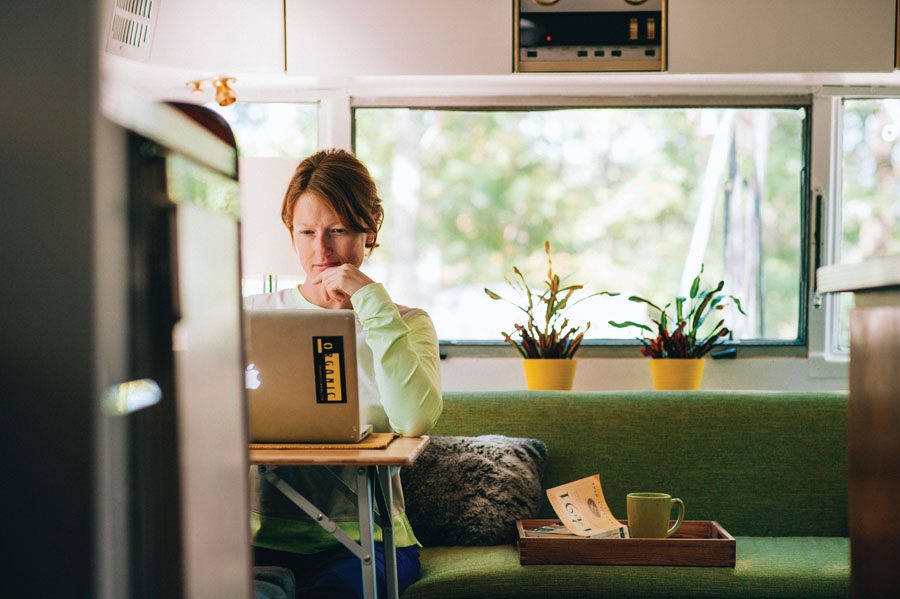
“We realized we didn’t want to sign a lease and jump back into work full-time and start the cycle all over,” Andy says. “We started brainstorming ways we could somehow connect adventure with design and helping people, and that’s how we came up with the DesignEgg (designegg.org) project. We wanted to have a purpose on the road and not just a selfish climbing lifestyle.”
Between 2014 and 2016, Andy and Jess did just that. After successfully meeting their Kickstarter fundraising goal, the couple bought and renovated a fiberglass Scamp trailer, dubbed it the “DesignEgg,” rented out their condo, and hit the road. Their project attracted the attention of Fractured Atlas, a nonprofit arts service organization. Between Kickstarter donations and the support of Fractured Atlas, Jess and Andy provided over $40,000 of creative services to 29 nonprofit organizations, artists, and entrepreneurs. And, of course, they climbed, from Kentucky to California and everywhere in between.
The Wickstroms have since sold their Chicago condo and upgraded the Scamp to a 1969 Airstream, or “Silver Egg,” which serves as both home base and mobile headquarters for their design firm Silver Egg Studios (silver-egg.org). They operate entirely on solar power and coffee. In the colder months, they’re usually posted up in El Paso, Texas, for the warm weather and stellar bouldering, but come fall, it’s back to the Red.
Jess + Andy’s #ROADLIFE Tips
Plan ahead and prepare.
There’s a reason this is the first principal of Leave No Trace outdoor ethics. Hitting the road without some semblance of a plan, however loose, is a recipe for disaster. “Since we’re climbers, our trajectory is roughly based on the climbing season,” Andy says, “but ultimately, wherever we go, even if we like the climbing in one area, if we can’t check our email or place calls, it’s out. Power, food and water, and cell service. If we have those three things, we feel like we’re effective both as employees of our business and as climbers.”
Measure your power needs before you hit the road.
If you’re trying to work remotely like Andy and Jess, plugging into the car’s cigarette outlet or paying for an expensive electric hookup might not cut it for the long term. Silver Egg Studios runs on a Renogy rooftop solar system, but the Wickstroms initially used GoalZero solar panels to offset their energy usage. The key to maximizing your solar power, says Andy, is to invest in roof brackets that allow you to tilt the panels.
Make Walmarts, Starbucks, and PUBLIC land your friends.
“Walmarts make really great campsites for your in-transit periods,” says Andy. “They’re right off the highway, they’re everywhere, and they’re free.” The only downside, he adds, is that Walmarts aren’t necessarily the most scenic or conducive to a good night’s sleep. Still, it’s a great place to grab a few hours of shuteye, however fitful. Starbucks are equally accessible with regards to caffeine and WiFi. For backdoor access to recreation at an extremely affordable rate (i.e. free), Andy says all roadlifers should be sure to take advantage of BLM and National Forest land.
Incorporate side trips.
Whether it’s finding day hikes or hot springs, visiting art museums or good restaurants, mix it up and get a taste of the local flavor. “We kinda get burned out on the culture of climbing here and there,” says Andy. “It’s nice to recharge by talking with people who have other interests.”
[nextpage title=”Read on!”]
The Toyota Tacoma
Jason Specht
@msoverland
Before the road life thing was hip, Jason Specht and his high school buddies were camping out of their trucks on the weekends. Other youthful pastimes like going to the movies or shopping at the mall held little interest with Specht’s crew—if it didn’t involve fishing, dirt roads, and camping, they wanted no part of it.
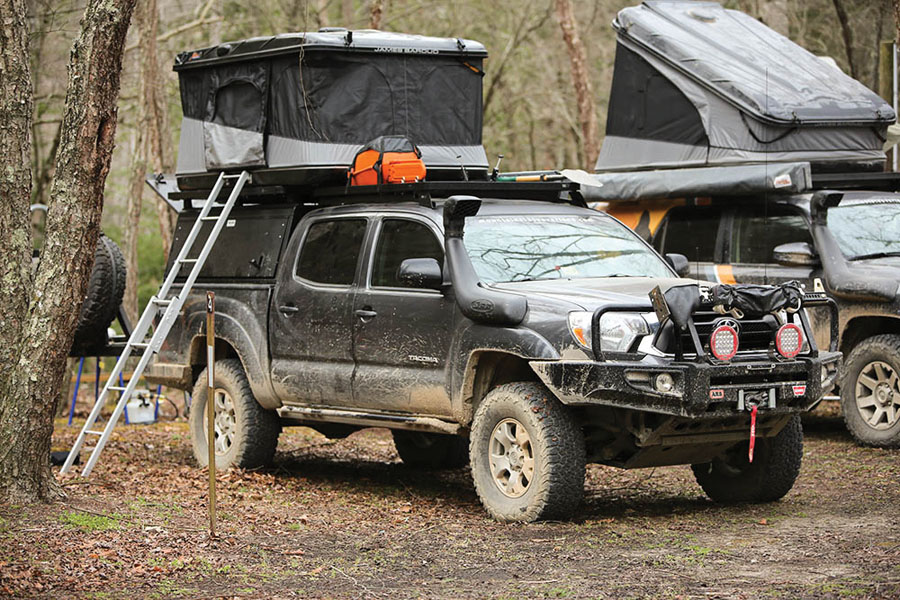
But still, car camping was a weekend thing, a hobby more or less. The idea that camping in the woods with your vehicle could be a marketable concept never crossed Specht’s mind until the year 2013. It was a West Virginia Mountaineers football weekend, and Specht and his friends were posted up with their trucks, some fly rods, a radio for the game, and a deep fryer for the eventual celebratory turkey. The spring rains had washed away any hope of catching fish, so Specht and his buddies huddled under tents, munching on turkey meat and reminiscing about old times.
“Somebody brought up overlanding, which is this concept of roughing it but with car camping that focused on gravel travel and country roads and rural America, and we thought, we have been doing this all of our lives,” Specht says, “why not plan some more trips, I have a camera, and we could just start documenting our adventures?”
So they did it. Now, four years later, Mountain State Overland maintains an established adventure travel YouTube video series with over 18,000 subscribers and 45,000 followers on Instagram. Each episode highlights road trips and adventuremobiles up and down the Appalachian chain, oftentimes interweaving the team’s personal interests in renewable energy practices and users. New for Mountain State Overland this year is its overlanding guide service.
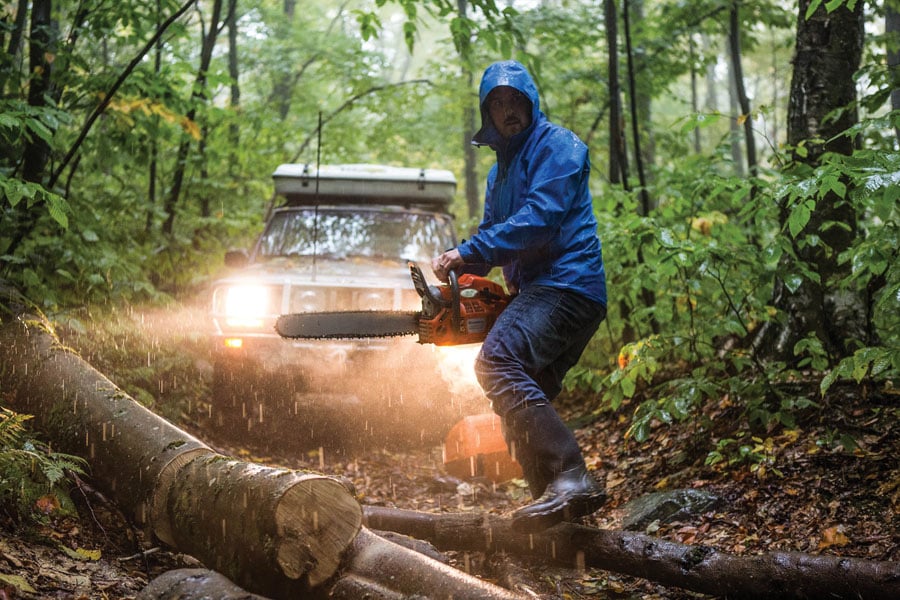
Specht doesn’t live on the road full-time, though he racks up quite a few trips in his souped-up 2013 Toyota Tacoma. He’s worked through a number of truck build-outs, from crafting his own full-size bed and drawer system to upgrading the suspension system and adding a hardshell rooftop tent. He says the goal of Mountain State Overland, first and foremost, is to put to rest the “unobtainium” so often associated with the world of overlanding and show viewers the beauty, and affordability, in a DIY mindset.
“Those half-million dollar global expedition vehicles are cool, but they’re not practical,” says Specht. “People can buy a 10-year-old 4Runner and create opportunities for travel and adventure here in our backyard. That’s so much more obtainable.”
Jason’s #ROADLIFE Tips
Get your hands dirty.
The fun in road life, whether you’re a weekend warrior or a full-timer, is dialing your system. It’s an endless process with constant tweaking and refining. In essence, road life is art. “The more you build, the more you craft whatever’s associated with your van or truck, the more you can connect with the lifestyle,” says Specht. “If you just went out and bought everything from a box store and had somebody put it on your truck, you’re totally not catching the big picture. You’re not identifying with the culture.”
Invest in tires.
For all of Specht’s preaching about DIY, there are a few things he simply cannot build, namely suspension systems and a set of tires. The latter, he argues, are worth the extra attention. “The tires are probably the single most important thing on a vehicle,” says Specht. Know the terrain, and the weather conditions, of where you plan on traveling and find a set of tires to fit those needs.
Don’t build it till you need it.
Especially in the world of overlanding, Specht has witnessed far too many bug-eyed, gearheads splurging on all of the latest and greatest equipment for their vehicles. But if you don’t need all of that gear, he argues, haven’t you missed the freedom of simplicity that’s inherent to road life? “As I was going on trips, I’d come back and realize what I need to do to make my experience better,” Specht says. “Don’t go out and buy it or build it until you realize you need it, and then continue to perfect the process indefinitely.”
Make the journey the destination.
Roadlifers are often stereotyped as bums and vagabonds, but Specht knows the economic impact travelers can have on small mountain communities. During a recent three-day, 350-mile guided trip, Specht pulled over the convoy in Hillsboro, W.Va., to stock up on fuel. “We rolled in there with seven trucks that all needed a full tank of gas, and that lady at the gas station didn’t know what to do with herself,” says Specht. “They don’t accept credit cards at the pump, they keep transactions in a notepad, and I’m used to that, but everyone else isn’t. They get to live and breathe and smell the culture, and that alone is having a positive impact on the gas station attendant and her lifestyle and everyone else who isn’t used to having a credit card insert. A $1500 bumper and traction pads don’t do anything for you. It’s the fun stuff that happens in between.”
[nextpage title=”Read on!”]
The Vanagon
Brooke German + Nick Derrick
@thisvanagonlife
Love at first sight might very well be cliché, but for Brooke and Nick, the saying is absolutely true. At least when it came to their 1987 Volkswagen Vanagon.
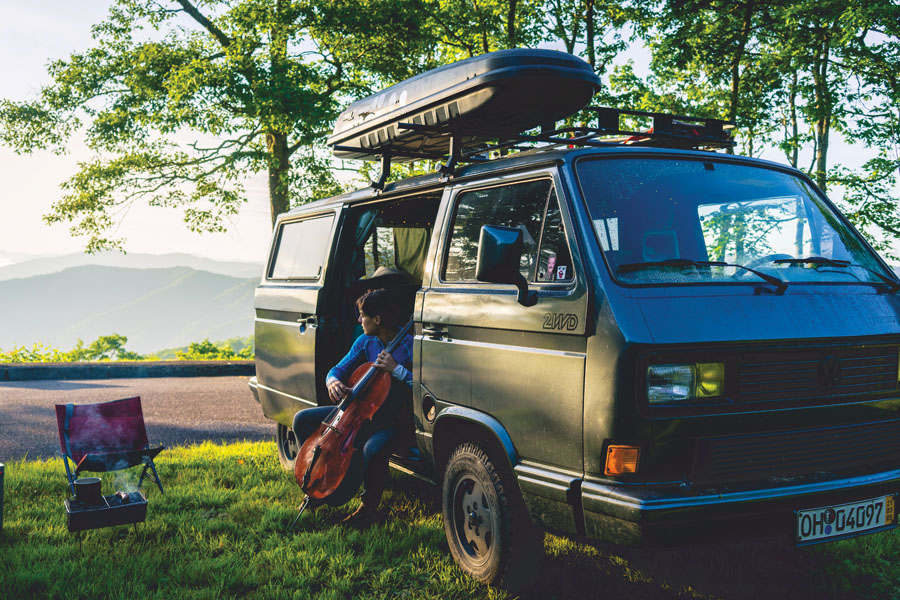
By most standards, the couple’s first sighting of the van should have sent them running in the opposite direction—it had a blown motor and countless forklift dents from its former junkyard home. But Brooke and Nick saw past all of that. Maybe because Nick knows a thing or two about automotive paint and bodywork. With the help of Asheville Vee Dub, Nick and Brooke spruced up the van, replaced the engine, built a cabinet system, and eventually added off-road suspension and tires. The couple lived on the road full-time for over four months, traveling from their home in Asheville, N.C., to California and back, where they then lived out of the van on Ocracoke Island during the off-season while fixing up some family property.
Transient musicians and artist-adventurers at heart, #vanlife suited the couple. Nick was already accustomed to living on the road from a cross-country motorcycle trip he took just months before he met Brooke in 2010. Brooke had never lived on the road per se, but she was used to making the seasonal flop between the Southeast and Park City, Utah, for ski season, so the idea had always appealed to her. Still, that’s not to say the four months they spent on the road were without some teachable moments.
“I think there’s this really romantic idea of van life, and in a way, it is romantic, but there are a lot of hardships, too,” Brooke says. “It’s a balance of give and take that’s all worth it when you wake up to the most epic view ever or start a dialogue with people you might not otherwise.”
Recently, the couple has come into the possession of a Volkswagen Westphalia, which they intend to take parts and pieces from to continue the Vanagon’s improvements. Among the list of upgrades are a pop-up camper top, a water tank, and a refrigerator. Though Nick and Brooke are back in Asheville for the time being, they’re still scheming road trips both big and large.
“When we were in Asheville before, we were getting lost in our careers and we knew that before we got more lost, we just really wanted to experience living on the go,” Brooke says. “Now that we’re stationary and have an actual home, our van is our vessel for nature, our mobile vacation home. It meets the needs we have and it’s a fun way to get creative.”
Brooke + Nick’s #ROADLIFE Tips
Be prepared to learn.
Maybe you’re attracted to the DIY nature of living on the road specifically because you have a background in carpentry, automotive repair, or mechanics. Maybe you’re interested in roadlife because it’s a step way outside your comfort zone. Whatever the reason, and whatever your skillset, be prepared to learn regardless. “If you’re going to buy a Vanagon, particularly a Volkswagen, it can be a little bit of a rough road. You definitely need to buy one that’s decently in shape if you don’t want to work on it, which can be upwards of $10,000,” says Nick. “If you’re going to have a van and you’re trying to outfit it by yourself, it’s always going to be a project. You’re always going to change stuff. There’s never really an end, but that’s kinda the joy of it, too.”
Take it for a test run.
There’s nothing worse than setting off on your long-anticipated road trip only to arrive at camp and realize you forgot to get batteries for your camp lights or fuel for the stove. “Go camping a lot before you decide to set off for an extended period of time, because there are so many things you just won’t think of until you really hit the road,” says Brooke. “After a week or two of people thru hiking on the Appalachian Trail, they send back a box of stuff, and we did the same thing.”
Simplify your setup.
Once you’ve hit the road, you’ll quickly realize what gear you need to have and what gear you don’t. Living out of a vehicle, whether it’s a Honda Element or a Ford Transit, forces you to downsize, and the more you simplify, the easier roadlife will be. “It took us a long time to figure this out, but you should minimalize your set up time,” says Nick. “The faster you can setup and be comfortable, fast as in 10-15 minutes, is crucial if you ask me.”
Connect with the culture.
Living out of a vehicle, whether it’s a Volkswagen Vanagon or a minivan, is not only widely accepted, but downright hot. Everybody and their moms are living on the road, it seems. Facebook is a great place to start connecting with these likeminded wanderers. Nick and Brooke utilized the Facebook group Vanagon Owners for sourcing information about the build-out process in particular. “It’s amazing because you have a whole community of people who have either experienced your specific problem themselves or who can at least help answer the question,” says Brooke.
[nextpage title=”Read on!”]
The Sprinter Van
Sarah Wood
@sarahnwoody
Between 2012 and 2016, Sarah Wood was on the road. A lot. As Executive Director for the adventure film festival 5Point Film Fest, Wood frequented airplanes and friends’ couches more than her home in Carbondale, Colo. It seems like a pretty rad job, and it is, but the day-to-day reality of that type of on-the-go work doesn’t always lend itself to the cool activities it promotes.
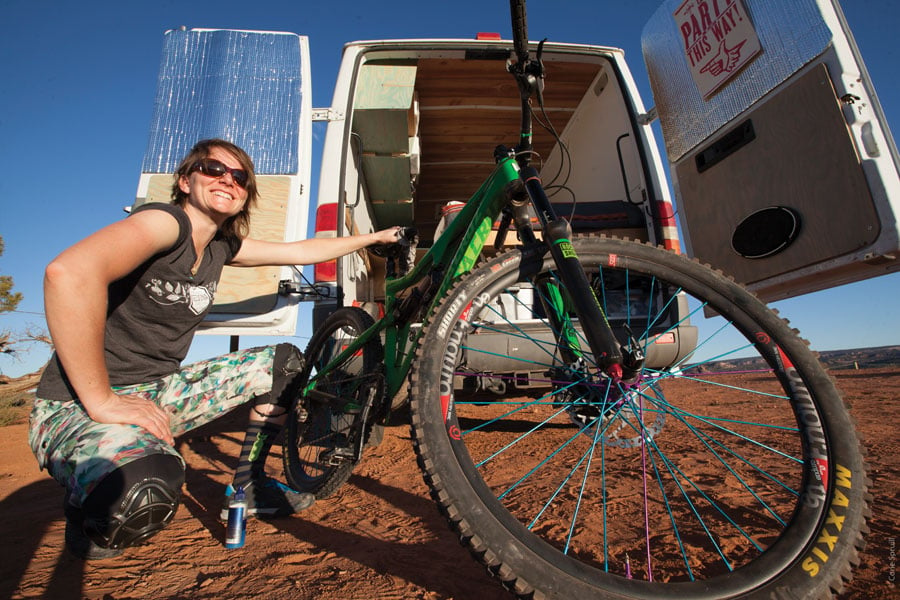
“I was on the road over 200 days a year, and it really didn’t make sense for me to keep an expensive little studio apartment,” Wood says. “Plus, there were lots of opportunities I missed on the road because I couldn’t always take my bike or my skis. In a way, I was sacrificing some of my personal health and satisfaction. The work-life balance was really out of whack for me because when I was traveling, I couldn’t participate in these outdoor communities like I wanted to.”
It was her dad that came up with the solution—buy a van and ditch the apartment. Wood had already been thinking about the idea, so it didn’t take much for her to make the leap. Not long after making the decision, she found a partially built-out 2006 Dodge Sprinter in Denver, and within a week, she had the keys to her new mobile home.
The van was already insulated and came complete with solar power, but the bed was too big, especially if Wood was going to store her bike inside (one of her top priorities, of course). A Jane-of-all-trades, Wood herself replaced the flooring, cut the bed down in size, and installed a sweet six-speaker sound system (having previously worked in the music industry, this was a non-negotiable splurge), all for less than $2300.
“I grew up in a handyman’s home. My dad was constantly pulling me in on projects around the house, so I’m familiar with how to use power tools,” Wood says. “That part wasn’t intimidating. The intimidating part was making the decision on the final layout, because once I’m in it, I don’t have time to mess around.”
After two weeks of mostly trial-and-error design, Vanna White, as Wood’s Sprinter came to be called, was complete. From October 2015 through September 2016, Wood traveled throughout North America, from Asheville to Squamish and Banff, racking up over 30,000 miles in her new rig. She mostly traveled solo, unless you count her two-wheel steed as a copilot, and while many have a hard time envisioning such an immense amount of alone time, Wood says that was her saving grace.
“I know that’s not for everybody, but when you can turn off after a hard day of meetings or driving or phone calls and constant interaction, for me, I needed that space to myself,” Wood says. “I had no lack of offers for spare bedrooms and couches, and my network has since become much larger because of the vanlife lifestyle and working through the outdoor industry, but I operate best with a pretty healthy dose of solitude.”
After the 2016 season of 5Point Film Fest, Wood took a job with Industry Nine in Asheville, where she now works as an Instigation Engineer for the bicycle components manufacturer. Vanna White still gets plenty of action, and sometimes Wood will hit the road for a few days a week, just for the hell of it.
Sarah’s #ROADLIFE Tips
Don’t be afraid to ask for help.
Even if you’re like Sarah and have plenty of experience in the way of carpentry or machinery, making a van, or any vehicle for that matter, livable is a different beast. “None of my lines were straight, but they’re close enough. For me, I was really stoked about the challenge of figuring this out, but I was under a deadline, too,” says Wood. “I didn’t have a lot of time to think through all of the little things,” like roadlife hacks that seasoned vanlifers might already know.
Bring a bike.
This is especially true for the long-term roadlifers who plan to be on the go for more than a week. If your mode of transportation is also your home, it can be a little cumbersome to move it once you’ve set up camp. For Wood especially, having her bike allowed her to break up the long trek from coast to coast. “I would line up my route from point A to point B so that my drive included a trail somewhere in the middle of the day,” says Wood. “Like Kansas, for example, has this really cool 20+-mile singletrack system right off I-70. It’s literally 20 minutes off the highway and I’d hit it every time. That made traveling way more digestible and keeps your head in a good space.”
Pay attention to time zones.
If you’re crossing through multiple states, be aware of when you leave and when you predict you’ll be passing through an urban area. Wood always made note of major cities along her route and tried to avoid rush hour in those areas. “If I’m going east especially, I get up an hour earlier because I know I’m losing time,” adds Wood.
Use whatever car you’ve got.
If you’re feeling all inspired to go out and drop 10 grand on a Sprinter van, pump the brakes. Take a few weekend trips in whatever vehicle you have and get comfortable with the idea of living out of whatever you can fit in your trunk, first. “If you have space, you’ll fill it,” says Wood. “I’m definitely not a clutter person, but when you start getting rid of things you don’t need because you don’t have the space for it, you realize that there’s always something you can free yourself of. I can live incredibly comfortable without 75 percent of the things I own, and that was great to feel and actually learn about myself on the road.”
[nextpage title=”Read on for 5 Favorite Road Trips!”]
5 Favorite Road Trips
You don’t have to live in a built-out Sprinter van in order to get a taste of #ROADLIFE. Hit the road this summer with these five weekend itineraries for our #ROADLIFE experts’ favorite adventure basecamps.
Western North Carolina
Basecamp: Brevard, N.C.
Activities: Mountain biking, hiking, swimming hole hunting
Camping: Avery Creek Road and Forest Service Road 5000 (first-come, first-serve, but free); Davidson River Campground ($22 per night); The Bike Farm ($20 per night).
Sarah Wood’s Favorite Rides: For classic technical Pisgah fun, Club Gap climb to Avery Creek descent or the Bennett Gap Loop. A more intermediate-friendly introduction to Pisgah riding can be found in the North Mills Recreation Area. Spencer Gap and Fletcher Creek still have some technical sections but sprinkled among ample miles of flow trail.
Extracurriculars: Fishing or floating the Davidson River, riding or hiking in DuPont State Forest, dipping beneath curtains of water in the Land of Waterfalls
Eats: Caffeine buzz at Quotations Coffee Cafe ; soups and sammies at Blue Ridge Bakery ; grab-and-go food at Food Matters Market; Sunday brunch at The Phoenix; calf-sized burritos at Pescados; authentic Thai food at Pad Thai; local brews and bike beta/gear at The Hub and Pisgah Tavern; beer and good company at Cedar Mountain Canteen .
Eastern Kentucky
Basecamp: Beattyville, Ky.
Activities: Climbing, hiking
Camping: Lago Linda Hide-A-Way ($6 per person, per night + $2 for electricity per site, per night); Miguels Pizza ($2-5 per night)
Andy Wickstrom’s favorite climbs: Park at Muir Valley and pay $10 per car to climb. This is a nonprofit climbing and nature preserve in the Red River Gorge, so know that money is going to a good cause. There are over 400 climbs here, ranging from beginner friendly sport routes to expert trad lines. Check out Great Wall, Johnny’s Wall, and Bruisebrothers for beginner routes and The Solarium, Midnight Surf, or Sanctuary for more experienced climbers. Grab the Kentucky classic beverage Ale-8-One at the parking lot soda machine on your way out.
Extracurriculars: Tasting Kentucky Bourbon at Town Branch Distillery in Lexington, exploring the Red River Gorge’s natural arches like Turtle Back Arch and Indian Arch, hiking the Sheltowee Trace Trail
Eats: Breakfast tacos and grassfed burgers at Red River Rockhouse ; beer and pizza at Miguels; locally brewed beer at C&S Carryout ($$—Andy recommends Country Boy Brewing’s Cliff Jumper IPA or Amos Moses Brown Ale)
Coastal Carolina
Basecamp: Ocracoke Island, N.C.
Activities: Surfing, cycling, fishing
Camping: Ocracoke Campground ($28 per night)
Brooke German’s + Nick Derrick’s Ocracoke Oasis: Hit the waves either north of Ocracoke Village or down South Point Road. Surfers will need a permit to drive their vehicle ($50 for 10 consecutive days, available at one of three nearby visitor centers) on South Point Road, but the swells are totally worth it. Afterwards, take a spin around the island by bike. Springer’s Point is a must-see stop on the island.
The 120-acre nature preserve is steeped in maritime history, but is most well known for Teach’s Hole, the location of the infamous pirate Blackbeard’s last stand. Catch the Morris Marina Ferry to see Portsmouth Island, a 13-mile barrier island just to the south of Ocracoke that is mostly undeveloped, save for a few National Park Service cabins on its southern end. Explore its wild shoreline and fish to your heart’s content. Spend the day or the entire weekend camped out on one of the Outer Banks’ few isolated and largely untouched islands.
Extracurriculars: Deep sea fishing in the Gulf Stream, touring the island’s 19th century British cemeteries, digging for clams at low tide, posting up on the porch of Zillie’s Island Pantry with a bottle of wine
Eats: Breakfast burritos and fresh fish tacos at Eduardo’s Taco Stand; island-brewed beer at 1718 Brewing Ocracoke ; smoothies and coffee at Ocracoke Coffee Company; wood-fired pizza and live music at Dajio; sweet and savory carb fix at Graceful Bakery
Southern West Virginia
Basecamp: Marlinton and Fayetteville, W.Va.
Activities: Biking, fishing, paddling, hiking
Camping: Greenbrier River Trail primitive camping (free); Watoga State Park ($22 per night); American Alpine Club-New River Gorge Campground ($20 per night for AAC members, $30 for non-member)
Jason Specht’s Multisport Itinerary: Head into West Virginia near Lake Sherwood Recreation Area and follow the winding roads to Watoga State Park. Bike, hike, or fish along the 78-mile Greenbrier River Trail. Jack Horner’s Corner in Seebert, W.Va., has a rental fleet of bikes and can help set shuttle for river floats or bike rides along the Greenbrier. Continue west through Droop Mountain Battlefield State Park and soak in the impressive sights atop Beech Ridge wind farm as you head southwest toward the New River Gorge. History buffs should make a stop at the Glade Creek Grist Mill at Babcock State Park, constructed out of salvaged mill parts dating back to the late 1800s.
Extracurriculars: Touring Virginia’s oldest covered bridge, Humpback Bridge, in Covington, Va., rafting the New River Gorge, biking or hiking the Arrowhead Trails, sport climbing above the pristine waters of Summersville Lake
Eats: Lunch at A&B Bakery, Covington, Va. ($); gourmet sandwiches at Secret Sandwich Society, Fayetteville, W.Va. ($$); locally sourced dinner at The Station, Fayetteville, W.Va. ($$$)
Central Virginia
Basecamp: Lexington, Va.
Activities: Hiking, fishing, floating, biking
Camping: Close proximity to town and adventure at Glen Maury Park ($18 per night); camp and float alongside the James River with Wilderness Canoe Company ($35 per night)
Jess Daddio’s Lexington Like a Local: Scramble up and over the boulderfield at Devil’s Marbleyard. The three-mile out-and-back hike is great but the views of the Shenandoah Valley are even better. Take a tour of the underground otherworld that is the Caverns at Natural Bridge. If water levels are cooperative, fish and float the James or Maury Rivers. Both of these waterways offer more smallmouth bass, catfish, and bluegill than you could ever hope to catch in a day. No visit to Lexington is complete, though, without a two-wheeled tour around the bucolic countryside. Just outside of town are rolling, quiet roads perfectly suited for riders of every ability level.
Extracurriculars: Scenic driving along Route 39 through Goshen Pass (though biking or paddling it is better), llama trekking at Applewood Inn, peaceful strolling through Boxerwood Nature Center & Woodland Garden, bluegrass pickin’ at the Lime Kiln Theater.
Eats: Classic American diner breakfast at Niko’s Grille; deli-style lunches with a vegetarian-friendly twist at Kind Roots and Blue Phoenix Café & Market ; farm fare dinner at The Red Hen; beers, wafflewiches, and open mic night at Brew Ridge Taps; local suds at Blue Lab Brewing Company and Devils Backbone Outpost ($$); vino of the Valley at Rockbridge Vineyard.
